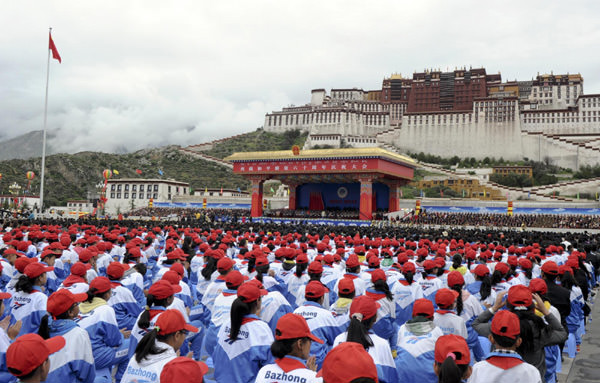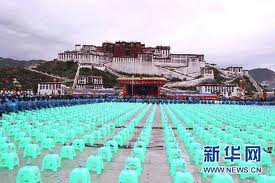Much of the talk about Vice President Joe Biden’s four-day visit to China last week centered on the man who hosted him: Xi Jinping, expected to become the country’s next president in 2012. Biden’s office has said that the principal purposes of his visit were “to build a relationship with Vice-President Xi” and “to get to know China’s future leadership.” But working out the thinking of China’s leaders has always been extremely difficult, and Xi is no exception.
Apart from an unusually rambunctious speech in 2009 when he lambasted foreigners and their “full bellies,” Xi’s political inclinations remain a black box. His public speeches have mostly consisted of boilerplate prose. In his most recent major speech, for example, delivered on July 19 in Lhasa, he began by saying that “the people of all ethnic groups in Tibet are chanting merrily to express their happiness and joy” and ended with a call to “fight against separatist activities by the Dalai clique.” The rest was mainly about China’s achievements in boosting the economy in Tibet—standard fare for Chinese leaders.
But the Lhasa speech was broadcast live on Chinese state television, an exceptional event and an indication of its national importance. Watching Xi deliver it gives a much more complex impression both of him and of China: the visual information largely conveys the opposite of Xi’s words.
The footage shows that Xi delivered his speech from a viewing platform erected in a vast new square in front of the Potala Palace, the Dalai Lama’s former residence in Lhasa. Banners above the stage show that the speech was part of the ceremonies marking what China calls “the sixtieth anniversary of the liberation of Tibet,” a reference to China’s assumption of sovereignty over Tibet in 1951 following its invasion a year earlier. There are frequent shots of the audience in the square, which included, according to the official Chinese media, “more than 20,000 Tibetans of all walks of life.”
But the footage does not support this claim. For one thing, only two monks are shown among the 20,000 people in the audience—one of them is shown repeatedly—suggesting that Tibetans from a “walk of life” that is integral to Tibetan society were not invited. As for women, there are many in the audience, but among the 200 or so senior Chinese and Tibetan officials who are shown seated on the viewing platform, all but five are men.
Another detail stands out too: No one in the audience has a chair.
According to China Daily, Xi Jinping had brought with him 300,000 cold-proof stainless kettles, 710,000 stainless pressure cookers, 60,000 quilts, and 150 computers as gifts for the Tibetans. But, apparently, not chairs.
The audience is seated on little plastic stools, about nine inches off the ground, arranged in straight rows in the vast new square, without a single broken line in either direction. They are arranged in blocks according to their profession or ethnicity, and thus to the color of their uniform or costume. One block of six hundred or so is green, which means it is the soldiers; another block is white, which is the doctors in their lab coats; a third block is light blue, which is the primary school children in their uniforms. The black block is that of junior officials wearing suits, most of whom seem to be Chinese, and the red block is Tibetan women from some area or group who have been assigned to wear Tibetan robes of the same color.
I recall that when the stools were introduced for audiences at these mass rallies held to welcome state leaders in Tibet some ten years ago, they were seen as a sign of progress and a concession to the spectators, because presumably everyone had sat on the ground before. In the rural areas it remains like that, and official television news broadcasts in Tibet still show local leaders in county towns seated in chairs beneath lavish banners with slogans about development, lecturing Tibetans who are sitting silently in rows on the road.
The ceremony included speeches by three other Chinese leaders and one Tibetan, a local village chief, as well as a parade of marching students, militia and the military. It lasted for at least 147 minutes, according to the television footage, during which time everyone applauded on cue, at the end of each section of each speech. It must have been quite hot or tiring because some Tibetans in the square can be seen holding their heads in their hands and being comforted by other members of the audience. Occasionally one or two people get up and move, but for the most part, no one leaves his or her assigned spot. At the back of the crowd one can even see synchronized displays—words spelled out by rows of people holding up different characters that form huge slogans saying “We thank the Chinese People” and “Tibet’s Future Will be Better.” One could be forgiven at times for thinking that Lhasa had been taken over not by Beijing but by Pyongyang.
Advertisement
I was at the university in Lhasa in 2001, the last time an equally important Chinese official—Hu Jintao himself—spoke at such an event. He came to celebrate the 50th anniversary of the “liberation” and gave the same speech, almost word for word. I had seen it then on television, and the ceremony looked identical as well. In 2005 I was at Tibet University again during yet another ceremony (it was my last, because the cooperation program for our students from Columbia and other US universities was ended without explanation one year later) which that time marked the anniversary not of liberation but of Tibetans being given autonomy. Most of the Tibetans who were selected to be at that event were only told the night before that they were required to attend the ceremony the next day because of supposed security concerns. We foreigners were instructed not to leave the university until the event was over, and once we did, “not to look at anything we should not look at,” though we were not told what that was.
Those who were selected had to be in the square by about 5 AM, four hours or so before the ceremony started. Some of the rules of attendance during these events are known from a unique documentary called 16 Barkor Street South, made by the brilliant independent Chinese filmmaker Duan Jinchuan when the same ceremony was held in 1995 (again, to celebrate autonomy). In his film, an official is shown ordering the Tibetans who have been selected to go to the square not to drink too much beforehand because they will not be able to go to the toilet during the event. They are also ordered to wear Tibetan clothes. And they are told that if they wear clothes that have patches, it will be a “political offense,” which usually means a crime. And, at least as shown in the film, only Tibetans were required to attend, not local Chinese residents.
This year, the Tibetans in the square would again have been selected from their work units or residential committees and ordered to attend, and no one else would have been allowed to enter the square. This is at the heart of the interpretative problem surrounding the event: the crowd in the square was dwarfed by giant slogans saying “We thank you, CPC Central Committee.” How to explain that choice of slogan given that most Tibetans in the audience had been forced to be there? Wouldn’t most of them expect Party leaders to provide development and roads, and know that they are paid quite well to do so?
And why would Xi insist that “ethnic unity in Tibet has steadily enhanced” when the number of political protests and arrests in Tibetan areas has risen sharply in the last three years, or that “the religious beliefs of the people are fully respected and protected,” when all Tibetan students and Tibetan government employees in Tibet, including those in the audience, are forbidden from any Buddhist practices at all?
Some aspects of these events cannot be seen from the television footage alone; one has to be there on the ground. After the ceremony in 2005, we were all allowed out on the streets once the formal events had ended, and so I went to the Post Office, near the exit of the square, and joined a vast crowd of curious Tibetans to watch the participants as they left. But what we saw coming out of the square had not been visible on the television screen: hundreds of armed troops followed by armored personnel carriers, riot control vehicles, water-cannon trucks, barbed-wire laying machines, vehicles with gun turrets and other forms of military hardware.
The military vehicles and the troops were not visible in the footage of the ceremony this year either, but they were surely there again. Perhaps there is an underlying view that all Tibetans are rebels thirsting for a war. If so, it would explain why the head of China’s army had been sent to sit next to Xi Jinping on the stage during the ceremony. It would also explain why there were no chairs: presumably they are seen as potential weapons in the hands of imagined Tibetan rioters, more threatening than plastic stools.
Everyone can understand why China is proud of improving Tibetan infrastructure and wants to maintain its rule over Tibet, but it is not clear why its leaders, or even ordinary Chinese, expect forcing Tibetans to stage rituals of mass gratitude to Xi Jinping and the Chinese government not to fuel resentment. In any event, resentment seems to be spreading among Tibetans: last week on August 15 another Tibetan burnt himself to death, others say they have been tortured after staging minor protests, at least three of the 13 Tibetan areas in China remain closed to foreigners, and the state’s officially selected Panchen Lama cannot visit a monastery without a major security operation to prevent unrest.
Advertisement
How does Xi Jinping rationalize the practice of mass displays of forced gratitude, or the decision not to allow his Tibetan audience to sit on real chairs? Scholars talk of these rituals as a throwback to imperial traditions, as the legacy of Leninism, or as China’s way of dealing with the non-Chinese nationalities on its borders. But no one knows how leaders justify these practices to themselves. Joe Biden and the other US officials tasked with fathoming the logic of governance in China will not find the answer in their current visit. But at least they will get chairs.




